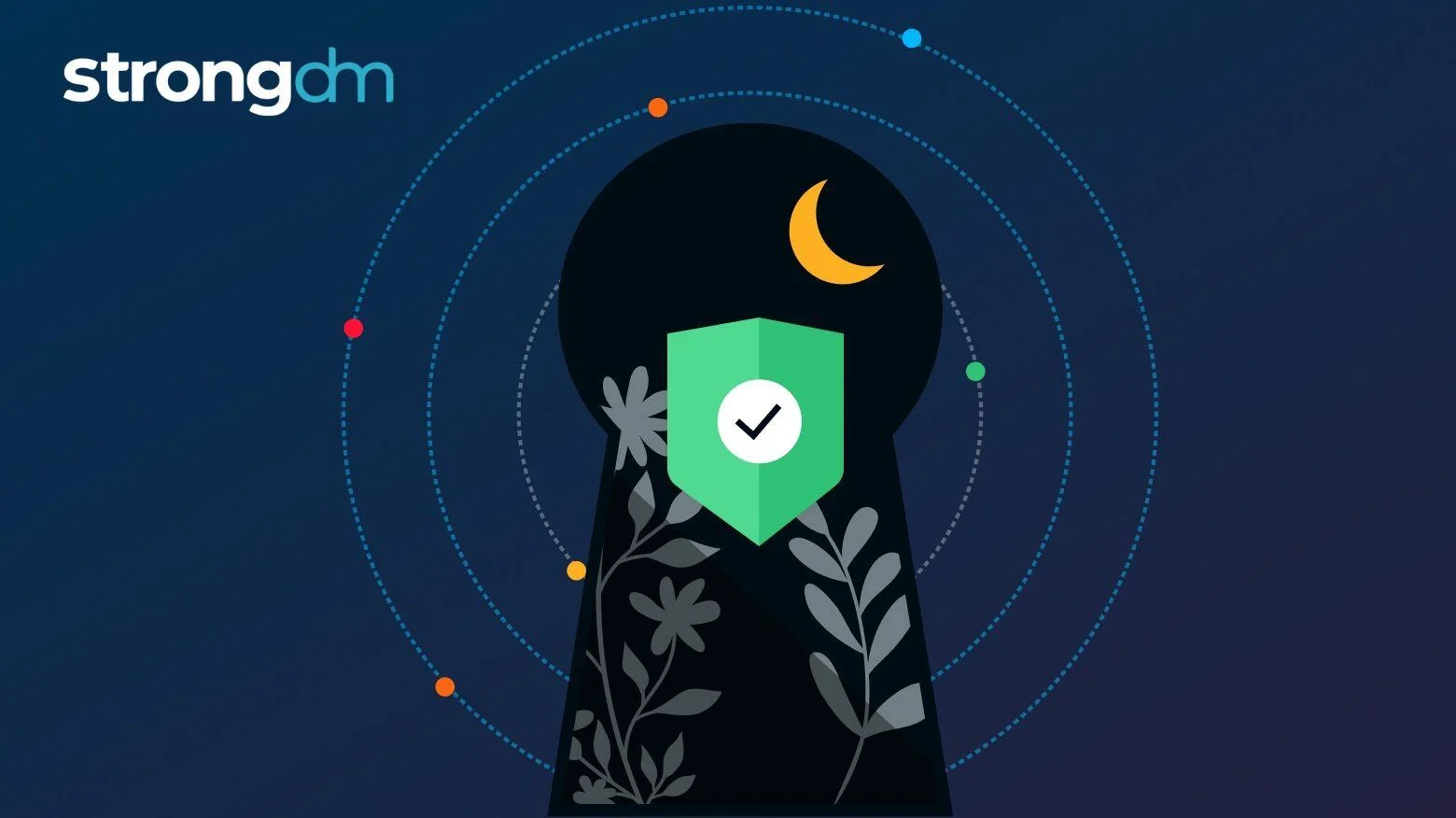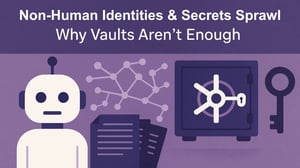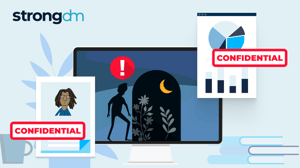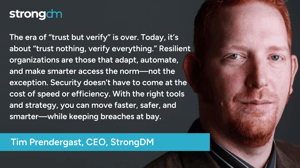

Written by
John MartinezLast updated on:
March 25, 2025Reading time:
Contents
Built for Security. Loved by Devs.
- Free Trial — No Credit Card Needed
- Full Access to All Features
- Trusted by the Fortune 100, early startups, and everyone in between
Cloud environments require the collective power of multiple tools to secure an enterprise’s infrastructure, but the data plane—the layer where data and systems reside and operations occur—often remains vulnerable to shadow access risks. The notion of “shadow IT” is a constant threat to all types of enterprise operations, but in this context, the threat of, shadow access means that unauthorized or unmanaged access can be created by well-meaning insiders who bypass formal processes, sometimes inadvertently, to achieve access.
Storing credentials in plaintext files, embedding secrets in source code, or creating personal copies of sensitive data are all shadow access risks that can expose organizations to data leaks, breaches, and compliance failures.
This blog explores how cloud providers address data plane security, why gaps exist due to the shared responsibility model, and how StrongDM’s Zero Trust Privileged Access Management (PAM) solution—enhanced with fine-grained authorization—addresses both managed and shadow access, securing the AWS data plane without hampering operational flexibility.
The Shared Responsibility Model and Data Plane Vulnerabilities
Under the shared responsibility model, cloud providers secure the underlying infrastructure, while customers are responsible for securing applications, data, and access within the cloud environment. For instance, while AWS may secure the compute instances that comprise managed RDS databases, managing who accesses that data, under what circumstances, and how those actions are monitored remains the customer’s responsibility.

The AWS Shared Responsibility Model places the responsibility of securing the data plane on the customer, and access management of critical resources is a primary consideration.
This shared model works well on paper but can create gaps when applied to data plane access. Specifically, the lack of controls around unmanaged, shadow access can undermine security by exposing sensitive data to unnecessary risk, even if not done maliciously. Examples of shadow access include developers storing access credentials in unapproved places (like local text files, Slack threads, or Git repositories), support engineers using shared credentials across environments, or administrators creating duplicate resources for testing without oversight.
While cloud providers offer native access control tools, they are heavily geared towards the control plane (APIs, CLI, and Console). These tools often lack the visibility, granularity, and centralized management required to detect or prevent shadow access to resources such as databases, Kubernetes clusters, and servers, across complex, multi-cloud environments.
Shadow Access Risks: When Well-Meaning Insiders Create Vulnerabilities
Shadow access usually stems from insiders who mean no harm but bypass security protocols to increase efficiency. For example, a developer might use an unsecured, direct database connection, with their own credentials, to speed up troubleshooting rather than waiting for formal access approval. In high-pressure environments, employees might store credentials where they can easily retrieve them (e.g., plaintext files), take local copies of data for faster processing, or leave cloud resources open for easier collaboration. While these actions are often convenient, they also introduce severe security risks, including:
- Unauthorized Access: Shadow access can inadvertently grant unauthorized individuals access to sensitive data, risking exposure and complicating incident response.
- Poor Credential Hygiene: Attackers can discover and exploit unmanaged credentials in plaintext files or source code repositories, potentially leading to data breaches or infrastructure compromise.
- Increased Attack Surface: By bypassing formal access controls, employees can unknowingly create entry points for attackers, expanding the organization’s attack surface and undermining existing security measures.
These risks underscore the need for a solution that governs managed access and addresses shadow access without hampering productivity.
StrongDM: Zero Trust PAM to Address Shadow and Data Plane Access
StrongDM tackles these challenges by combining Zero Trust Privileged Access Management (PAM) with fine-grained access control, providing the visibility, control, and policy enforcement needed to manage both traditional and shadow access. StrongDM’s platform creates a unified, flexible security model that enforces secure access to data plane resources while also reducing the operational drivers for shadow access.
Unified Access Control Across Environments
The approach used by the StrongDM platform unifies access management for resources across AWS, Google Cloud, Azure, on-premises environments, and even non-standard tools like databases or Kubernetes clusters. This reduces the need for users to seek “workarounds” since StrongDM makes accessing and managing resources easy, fast, and compliant.
Granular, Dynamic Authorization Policies
StrongDM’s fine-grained authorization enables organizations to create attribute-based policies that go beyond rigid role-based access. For example, policies can be set to limit access to production environments to “read-only” during specific hours or for certain user roles. This flexibility limits the need for shadow access, as users can receive only the permissions they need, when they need them, without storing extra credentials or creating additional, unauthorized access points.
Enhanced Visibility and Auditing
The platform provides detailed logging and session recording, allowing organizations to see exactly who accessed what data, when, and what actions they took. This enables real-time monitoring and retrospective auditing, making it easy to detect and address shadow access or unauthorized credential use. Visibility into access activities also helps enforce compliance by ensuring that credentials and actions are controlled and traceable.
Reducing Shadow Access with Zero Trust Principles
StrongDM’s Zero Trust model assumes that no user or device is inherently trustworthy. Every access request is verified based on context, such as location, time, and device security posture, enforcing least-privilege access in a controlled, continuous way. By applying Zero Trust principles, StrongDM reduces the opportunity for shadow access, as users no longer need to create workarounds or shortcuts to meet their access needs.
Addressing Insider Risks Through StrongDM’s Centralized Credential Management
One of the main drivers behind shadow access is credential sprawl, where users save credentials in various places for convenience. StrongDM mitigates this risk through centralized credential management, which benefits from these attributes:
- Vault-agnostic: The platform integrates with major secrets management solutions, including the built-in Strong Vault, to provide a seamless access experience across all landscapes and environments: in AWS, other clouds, or on-prem.
- Credentials are never exposed: Credentials for critical resources are securely stored and injected into authorized sessions at the time a session is initiated, so users never see them, and prevents personal, shadow copies from being made, or hardcodes into scripts.
The Road Forward: Minimizing Shadow Access and Data Plane Exposure
The cloud data plane and shadow access challenges are critical gaps in cloud security that can only be solved with a dynamic, centralized approach to access management. StrongDM fills this gap by integrating Zero Trust PAM, fine-grained authorization, and centralized credential management, providing a comprehensive solution for both managed and shadow access.
As cloud environments evolve and pressure increases on security teams to protect against both external and insider threats, a solution like StrongDM becomes essential. By securing and simplifying data plane access without creating productivity roadblocks, organizations can reduce shadow access risks and achieve a new level of visibility and control over their cloud and on-prem environments.
Conclusion: Embracing StrongDM to Mitigate Data Plane and Shadow Access Risks
Cloud providers provide a strong security foundation, but customers remain responsible for securing access within the cloud, particularly at the data plane level. Shadow access—driven by well-meaning insiders who bypass security controls for convenience—represents a significant risk in these environments.
StrongDM’s Zero Trust approach to PAM, combined with fine-grained authorization and centralized credential management, addresses these challenges by unifying access controls, reducing credential sprawl, and enforcing secure access. By embracing StrongDM, organizations can mitigate both data plane and shadow access risks, ensuring robust security without sacrificing operational agility.
Book a demo of StrongDM and see how our Zero Trust PAM platform can provide what your legacy systems can’t.
Next Steps
StrongDM unifies access management across databases, servers, clusters, and more—for IT, security, and DevOps teams.
- Learn how StrongDM works
- Book a personalized demo
- Start your free StrongDM trial

Categories:

About the Author
John Martinez, Technical Evangelist, has had a long 30+ year career in systems engineering and architecture, but has spent the last 13+ years working on the Cloud, and specifically, Cloud Security. He's currently the Technical Evangelist at StrongDM, taking the message of Zero Trust Privileged Access Management (PAM) to the world. As a practitioner, he architected and created cloud automation, DevOps, and security and compliance solutions at Netflix and Adobe. He worked closely with customers at Evident.io, where he was telling the world about how cloud security should be done at conferences, meetups and customer sessions. Before coming to StrongDM, he lead an innovations and solutions team at Palo Alto Networks, working across many of the company's security products.
You May Also Like




